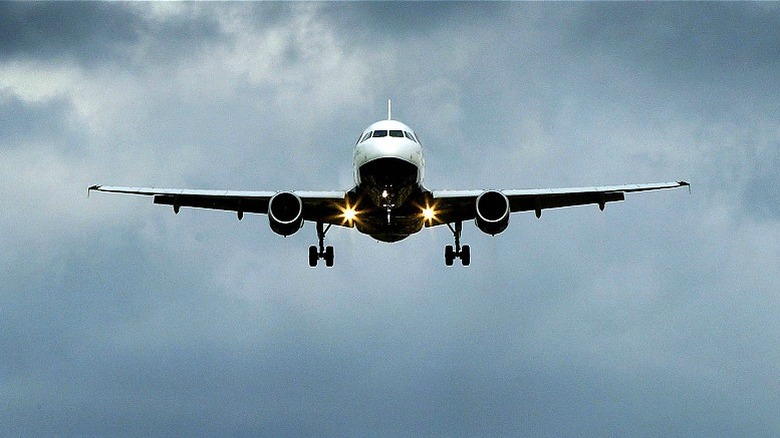Why Planes Look Like They Are Moving Slow, According To Science
It's one of the strangest things about air travel: You feel the rushing speed as the plane rolls along the runway, but once it's up in the air and reaches a cruising altitude, it feels as if you're hardly moving at all. And when you're on the ground looking up at a passing plane, it seems to drift along at a leisurely pace, not the hundreds of miles per hour it's really moving at. Forget airline peanuts; Jerry Seinfeld should've been asking what's up with that gap in perception.
As it turns out, what's up with planes and their deceptively slow appearance is relativity. For viewers on the ground looking up at an airplane, there are often no reference points by which to judge the plane's movement; i.e., a cloud to pass by or any contrails (vapor trails) to measure. Instead, a plane in the sky looks like a small blip against a solid-blue backdrop thousands of feet away from you. Without reference points, it's difficult to judge how fast an object is moving.
Another factor? The length of time it takes for a plane to cross our field of vision. Because it's so far away and so tiny, a plane can stay in your field of vision for a while — creating the illusion that it's crawling along (though, our brains know better). If it were flying closer to us, it'd move across our field of vision more quickly, and give us a better idea of its true speed. This effect is known as motion parallax.
Inside planes, you have few reference points
Per Flying Magzine, the average commercial airplane has a cruising speed somewhere between 550 and 600 miles per hour. When you're inside a plane (which is almost always painted white), you're moving at that speed, too. And it's because you're in the plane, zipping along with it, that you can't perceive how fast you're really going.
The reason why being in a plane feels so much slower than being in a car or a train is, like the perception of a plane's speed at a distance, a matter of reference points (rather, a lack thereof). In a car, you typically pass by all kinds of reference points, and they pass along your field of vision either quickly or not as quickly, depending on the speed you're driving. In a plane, though, these reference points are far, far fewer.
Sara Nelson, director of NASA's Iowa Space Grant Consortium at Iowa State University, broke down this concept in an article published on The Conversation website, where she noted, "This is the same reason why it can be hard to tell that you are driving quickly on a highway that is surrounded only by empty fields with no trees." Nelson further said that if when inside a plane, looking out one of the plane's round windows, you can spot the plane's shadow on the ground, you could get a sense of the plane's true speed.
Flights really are getting slower, though
As aerospace educator Sara Nelson explained, a lack of reference points is the main reason why planes can look to be moving so slowly in the sky, when they're really flying at a speed of around 575 miles per hour. But, on the note of slow airplanes, flights themselves are, in fact, slower today than they were some 50 years ago. Among the reasons why include airlines building in potential flight delays into flight times, and pilots flying at a slower speed as a way to save fuel.
The fuel-saving practice appears to date back 15 years or so. As a United spokesperson shared back in 2008, "What we're doing is flying at a more consistent speed to save fuel" (via NBC News). According to Forbes, jetBlue and Ryanair have also (since 2008) instructed their pilots to fly more slowly for this reason.
There are also practical and safety reasons for airplanes flying slightly slower today than they used to. Per "Wendover Productions," the turbofan engines used by most commercial aircraft operate most efficiently between 400 and 600 miles per hour. Faster speeds would need a jet engine, which guzzles through fuel at a furious rate, and going much faster — around the sound barrier, for example, which jet engines can breach — gets increasingly risky. So, considering all this, perhaps planes slowing down nearer to our perception isn't such a bad thing.


